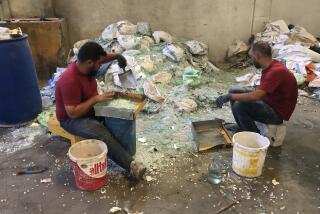How to Manufacture a Menagerie of Glass From Grains of Sand
- Share via
MILLVILLE, N.J. — Standing before the “glory hole” of a huge furnace, glass artist David Lewin withdrew a thin rod from a fire that burned at 2,250 degrees Fahrenheit.
Lewin blew into the rod carefully, his breath shaping the glowing orange blob of molten soft glass at the other end into the beginnings of a stylized vase.
The vase would become the latest work of art to be produced at Wheaton Village, a replica of a 19th-Century town in southern New Jersey that is a mecca for glass sculptors.
For anyone with a love of artistic glassware, a visit to the village is a must. Visitors can watch skilled artisans at work in a century-old factory known as “the glass monastery” and explore the Museum of American Glass, which features more than 8,000 works of art dating from Colonial days.
“Wheaton Village is a fabulous place for glass artists. There is nothing like it anywhere else,” artist Liz Marx said.
Lewin agreed: “For the glass artist, the museum is a tremendous resource.” Lewin, 35, an artist-in-residence from San Francisco, also praised the village’s 2,000-volume library on glass history and technology.
Using 100-year-old techniques and tools, the blowers and sculptors at the village’s replica T. C. Wheaton 1888 Glass Factory work side by side, surrounded by a towering chimney, glass melting and reheating furnaces, and grinding and polishing equipment.
“Glass can be rough or smooth, sensuous or brittle. It can be as solid as a rock or as fragile as an icicle,” said artist Patricia Malarcher.
“The aesthetics of working in a (replica of a) 19th-Century glass factory are pure heaven,” said Marx, of Los Angeles, who specializes in pate de verre, a French lost-wax technique using glass casting and molds.
“Studio glass is a new movement in the world of art, dating back only 30 years,” she added. “Before that, artistic pieces were primarily the work of sculptors working in large glass factories.”
Marx, 32, is one of 74 recipients of fellowships for artists that the Creative Glass Center of America, based in Wheaton Village, has awarded in the last eight years. The five-month fellowships include housing, a monthly stipend and supplies, and they offer the opportunity to establish a body of work.
For more than two centuries, southern New Jersey has been the cradle of American glass. German immigrant Caspar Wistar launched the nation’s first successful glass factory in nearby Alloway in 1739, and the area has been a major glass manufacturing center ever since.
In 1888, Dr. Theodore Corson Wheaton built his first glass factory in Millville, a mile from the present-day replica. There were 25 employees. Today, Wheaton Industries, one of the largest family-owned producers of glassware in the world, has 10,000 employees. The replica factory was built in 1970.
In his 1904 essay, “Reckless Ecstasy,” Carl Sandburg wrote about the vitality of the Millville glass industry at the turn of the century:
“Down in southern New Jersey they make glass. By day and by night, the fires burn on in Millville and bid the sand let in the light. Big, black fumes shooting out smoke and sparks, bottles, bottles, bottles, of every tint and hue, from a brilliant crimson to the dull green that marks the death of sand and birth of glass.”
More to Read
Sign up for The Wild
We’ll help you find the best places to hike, bike and run, as well as the perfect silent spots for meditation and yoga.
You may occasionally receive promotional content from the Los Angeles Times.






